List of World Heritage Sites in China
The United Nations Educational, Scientific and Cultural Organization (UNESCO) World Heritage Sites are places of importance to cultural or natural heritage as described in the UNESCO World Heritage Convention, established in 1972.[1] Cultural heritage consists of monuments (such as architectural works, monumental sculptures, or inscriptions), groups of buildings, and sites (including archaeological sites). Natural features (consisting of physical and biological formations), geological and physiographical formations (including habitats of threatened species of animals and plants), and natural sites which are important from the point of view of science, conservation or natural beauty, are defined as natural heritage.[2] China accepted the convention on 12 December 1985, making its sites eligible for inclusion on the list.[3]
China has 59 World Heritage Sites on the list, ranking second in the world, just below Italy with 60 sites.[4] Of these 59 sites, 40 are listed for their cultural, 15 for their natural, and four sites for both cultural and natural significance. In addition, China also has 59 sites on its tentative list.[3]
The first sites in China were added to the list in 1987 when six sites were inscribed. The most recent additions took place in 2024, when the Beijing Central Axis and Badain Jaran Desert were listed. One site is transnational, the Silk Roads: the Routes Network of Chang'an-Tianshan Corridor is shared with Kazahkstan and Kyrgizstan.[3]
World Heritage Sites
[edit]UNESCO lists sites under ten criteria; each entry must meet at least one of the criteria. Criteria i through vi are cultural, and vii through x are natural.[5]
| Site | Image | Location (province) | Year listed | UNESCO data | Description |
|---|---|---|---|---|---|
| Mount Taishan | 
|
Shandong | 1987 | 437; i, ii, iii, iv, v, vi, vii (mixed) | Mount Tai is the most important of the five Sacred Mountains of China. It is a giant rock mass covered with dense vegetation, towering over a surrounding plateau. Its natural beauty has inspired people for millennia. It was a site of the imperial cult for over 2,000 years, with emperors themselves performing Feng Shan sacrifices. There are numerous temples, stelae, and stone inscriptions on the mountain slopes, both Buddhist and Taoist. The mountain is connected with a series of historical events of China, including the emergence of Confucianism, the unification of the country under the Qin dynasty, and the emergence of writing and literature.[6] |
| The Great Wall | 
|
Beijing, Hebei, Gansu | 1987 | 438; i, ii, iii, iv, vi (cultural) | The Great Wall is a series of fortifications in northern China with a total length of over 20,000 km (12,000 mi). Construction of the Wall, intended as a defense against the invaders from the north, begun in the 3rd century BCE under the Emperor Qin Shi Huang who connected earlier existing sections. Work on the Great Wall continued until the 17th century under the Ming dynasty. The Wall comprises fortresses, watchtowers, passes, and shelters along the way. It has featured prominently in literature for centuries. Three sections of the wall are listed, the terminuses at Jiayuguan City and Shanhai Pass, and the Badaling section (pictured) near Beijing.[7] |
| Imperial Palaces of the Ming and Qing Dynasties in Beijing and Shenyang | 
|
Beijing, Liaoning | 1987 | 439bis; i, ii, iii, iv (cultural) | The Forbidden City in Beijing (the Hall of Supreme Harmony pictured) was the seat of the Ming and Qing dynasties from 1416 to 1911. The palaces in Beijing and Shenyang, where the Mukden Palace was added to the site in 2004, represent the development of palatial architecture in China and the fusion of Han, Manchu, Mongolian, and Tibetan cultures and influences, especially in the 17th and 18th centuries. The palace complexes are filled with works of art and also demonstrate the traditions of shamanism practiced by the Manchu.[8] |
| Mogao Caves | 
|
Gansu | 1987 | 440; i, ii, iii, iv, v, vi (cultural) | The caves in the Dunhuang oasis contain an outstanding collection of Buddhist art spanning from the 4th to 14th centuries. They reflect cultural exchanges between China, India, and Central Asia, as well as the art of various ethnic minorities of China. They also provide insight into the life and culture of the Sui, Tang, and Song dynasties. In the 19th century, the caves were occupied by Buddhist monks while they drew the attention of archeologists and were protected after 1930. One of the most prominent finds were the Dunhuang manuscripts which were discovered in one of the caves in 1900.[9] |
| Mausoleum of the First Qin Emperor | 
|
Shaanxi | 1987 | 441; i, iii, iv, vi (cultural) | The mausoleum was constructed for Qin Shi Huang of the Qin dynasty, the first Emperor of China and unifier of the country, who died in 210 BCE. The massive mausoleum comprises the grave mound with a height above 50 m (160 ft) and numerous accompanying pits with funerary objects. Of these, the most famous is the Terracotta Army (pictured), thousands of life-sized and realistic terracotta statues of warriors, as well as horses and chariots. The site was discovered in 1974.[10] |
| Peking Man Site at Zhoukoudian | 
|
Beijing | 1987 | 449; iii, vi (cultural) | Zhoukoudian (entrance pictured) is an archaeological site with limestone caves that preserved remains of ancient humans, tools, and animals from the Pleistocene. Excavations have been going on since the early 20th century. The finds include the so-called Peking Man, a subspecies of Homo erectus who lived 700,000 to 200,000 years ago, archaic Homo sapiens from about 200,000 to 100,000 years ago, and modern humans dating back to 30,000 years ago. They provide an important insight into the human evolution and the life of human communities in Asia.[11] |
| Mount Huangshan | 
|
Anhui | 1990 | 547bis; ii, vii, x (mixed) | Huangshan, or Yellow Mountain, is a granite mountain range with numerous peaks, boulders, caves, waterfalls, and rock formations. It has ancient pine trees and is home to a rich assemblies of bryophytes and ferns. There are several endemic plant species. The scenic landscape of the mountain has been inspiring the Chinese imagination since at least the time of the Tang dynasty of the 8th century. It has featured in poems and paintings and has a school of painting named after it. A minor boundary modification of the site took place in 2012.[12] |
| Jiuzhaigou Valley Scenic and Historic Interest Area | 
|
Sichuan | 1992 | 637; vii (natural) | The valley is surrounded by jagged mountain peaks reaching up to 4,800 m (15,700 ft) high. There are numerous karst features, including caves, limestone terraces, as well as pools and waterfalls, resulting in a scenic beauty. The valley has a series of diverse forest ecosystems that are home to some 140 bird species, the giant panda, and Sichuan takin.[13] |
| Huanglong Scenic and Historic Interest Area | 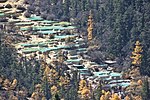
|
Sichuan | 1992 | 638; vii (natural) | The mountain landscape has glaciers, diverse forest ecosystems, waterfalls, and karst formations. A special feature is a series of travertine terraces and lakes (pictured). The area is home to the giant panda and golden snub-nosed monkey.[14] |
| Wulingyuan Scenic and Historic Interest Area | 
|
Hunan | 1992 | 640; vii (natural) | The defining feature of the landscape is the collection of more than 3,000 quartz sandstone pillars and peaks, some of which are more than 200 m (660 ft) tall. Other interesting landforms include karst caves with calcite deposits, gorges, ravines, pools, waterfalls, and two large natural stone bridges. The area is home to the Asian black bear, dhole, and water deer.[15] |
| Mountain Resort and its Outlying Temples, Chengde | 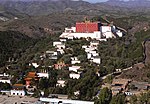
|
Hebei | 1994 | 703; ii, iv (cultural) | The resort was built in the 18th century as the summer palace for the Qing dynasty emperors. At the same time it functioned as a base to strengthen administration in the border regions. The palaces, temples, and gardens are designed to be integrated harmoniously with the natural environment, following the principles of feng shui. Several temples are in the styles of ethnic minorities of the empire. The Putuo Zongcheng Temple in the Tibetan style is pictured.[16] |
| Temple and Cemetery of Confucius and the Kong Family Mansion in Qufu | 
|
Shandong | 1994 | 704; i, iv, vi (cultural) | Qufu was the birthplace of Confucius, the great Chinese philosopher, educator, and politician, who died in the 5th century BCE. His teachings, known as Confucianism, were greatly influential in China, Korea, Japan, Vietnam, as well as in the 18th century Europe during the Age of Enlightenment. The temple was originally built in 478 BCE and was rebuilt and expanded over centuries. The continuous support of the emperors meant that the finest artisans worked on the complex which includes the Temple of Confucius (pictured), the Kong Family Mansion, and the Cemetery of Confucius where he and more than 100,000 of his descendants are buried.[17] |
| Ancient Building Complex in the Wudang Mountains | 
|
Hubei | 1994 | 705; i, ii, vi (cultural) | The religious complex in the Wudang Mountains was established as a centre for Taoism under the Tang dynasty in the 7th century. It reached its peak under the Ming dynasty between the 14th and 17th centuries. Today, the complex preserves 53 palaces, temples, and shrines in nine different architectural style, including those from the Yuan and Qing dynasties. The buildings represent the highest architectural and artistic standards of China through centuries and were influential in the development of public and religious architecture in the country. The Purple Cloud Temple is pictured.[18] |
| Historic Ensemble of the Potala Palace, Lhasa | 
|
Tibet | 1994 | 707ter; i, iv, vi (cultural) | The palace (pictured) in Lhasa served as the winter residence of the Dalai Lamas from the 7th century. It represents the role that Tibetan Buddhism had in the administration and governance of the Tibetan society. The vast palace is filled with works of art, including murals, painted scrolls, sculptures, and porcelain, and has a collection of important historic documents. In 2000 and 2001, respectively, the site was expanded to include the Jokhang temple monastery from the 7th century and Norbulingka, the summer residence of the Dalai Lamas from the 18th century.[19] |
| Lushan National Park | 
|
Jiangxi | 1996 | 778; ii, iii, iv, vi (cultural) | The cultural landscape around Mount Lu and Poyang Lake has been inspiring philosophers and artists for more than two millennia and was the cultural centre of southern China. There are more than 200 historic buildings in the national park, including Buddhist and Taoist temples and sites of Confucianist teachings, in particular the White Deer Grotto Academy. The stone arch Guanyin Bridge from the Song dynasty is important in history of Chinese civil engineering.[20] |
| Mount Emei Scenic Area, including Leshan Giant Buddha Scenic Area | 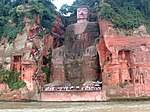
|
Sichuan | 1996 | 779; iv, vi, x (mixed) | Mount Emei is one of the four sacred Buddhist mountains in China. It is the site of the first Buddhist temple in China, constructed when the religion was introduced from India via the Silk Road in the 1st century CE. Today, there are over 30 temples from different periods on the mountain, as well as several important monuments. The best known is the Leshan Giant Buddha (pictured), a 71 m (233 ft) tall statue carved in stone in the 8th century. The mountain is also important for its animal and plant biodiversity, with forest types spanning from subtropical evergreen broad-leaved forest at the bottom to subalpine conifer forest at the highest elevations.[21] |
| Old Town of Lijiang | 
|
Yunnan | 1997 | 811bis; ii, iv, v (cultural) | Located on the meeting point between the Silk Road and the ancient Tea Horse Road, Lijiang was an important trade centre between Sichuan, Yunnan, and Tibet from the 12th century onward. It was a meeting point of Han, Nakhi, Bai, and Tibetan people and other communities, which is reflected in a particular local architecture, urban planning, and traditions. The city also demonstrates a harmonious coexistence of Confucianism, Taoism, and Buddhism. A prominent feature of the city is its traditional water supply system, with waters from the mountains being collected in the Black Dragon Pool and are then distributed through a series of canals and channels. A minor boundary modification of the site took place in 2012.[22] |
| Ancient City of Ping Yao | 
|
Shanxi | 1997 | 812; ii, iii, iv (cultural) | The city of Pingyao was founded under the Ming dynasty in the 14th century. The city centre (market tower pictured) is a well-preserved example of a Han Chinese traditional city and it demonstrates the evolution of architectural styles under the Ming and Qing dynasties. In the 19th and early 20th centuries, it was the major banking centre of the country. In addition to the old city centre, two temples are listed as well, the Zhenguo Temple and the Shuanglin Temple. Both are important due of their architecture and art collections.[23] |
| Classical Gardens of Suzhou | 
|
Jiangsu | 1997 | 813bis i, ii, iii, iv, v (cultural) | The design of Chinese gardens has been developing for more than two millennia. The gardens in the city of Suzhou demonstrate some of the finest examples of the form, including water features, rock formations, pavilions, bridges, and meticulously arranged plants, designed to create harmonious and miniature landscapes that reflect the natural world. Out of more than 50 such gardens in the city, four were listed in 1997, and a further five were added in 2000. They date between the 11th and 19th centuries. The Humble Administrator's Garden is pictured.[24] |
| Summer Palace, an Imperial Garden in Beijing | 
|
Beijing | 1998 | 880; i, ii, iii (cultural) | The palace was conceived next to the Kunming Lake in Beijing in the mid-18th century under the Qing Qianlong Emperor. It is a prominent example of a Chinese garden, with water features, pavilions, temples, and bridges. It had an important influence on subsequent garden designs. It was destroyed during the Second Opium War in 1860, restored in 1888, again damaged in during the Boxer Rebellion in 1900, restored, and has been a public park since 1924.[25] |
| Temple of Heaven: an Imperial Sacrificial Altar in Beijing | 
|
Beijing | 1998 | 881; i, ii, iii (cultural) | The Temple of Heaven in Beijing is the most representative of the sacrificial buildings in China. Its design and symbolic layout had an important influence on subsequent buildings. The original temple was constructed in 1420 under the Ming dynasty, together with the Forbidden City. The current layout dates to 1749, following a renovation under the Qing dynasty. The Hall of Prayer for Good Harvests, where the emperors offered sacrifice to Heaven for abundant harvests, is pictured.[26] |
| Mount Wuyi | 
|
Fujian | 1999 | 911bis; ii, vi, vii, x (mixed) | The area of Mount Wuyi preserves the largest largely intact examples of subtropical and rainforests in China. The forests are rich in biodiversity and home to several relict species. Along the Nine Bend River (pictured), there are high cliffs and sandstone rock formations. There is an archaeological site of a Han dynasty administrative capital from the 1st century BCE. There are also several temples and Confucianist learning centres that were associated with the development of the Neo-Confucianist philosophy in the 11th century. A minor boundary modification of the site took place in 2017.[27] |
| Dazu Rock Carvings | 
|
Chongqing | 1999 | 912: i, ii, iii (cultural) | This site comprises five clusters with rock reliefs near the city of Chongqing. They date from the 9th to the 13th centuries and depict Confucianist, Taoist, and Buddhist motifs, side by side. This demonstrates the harmonious coexistence of these three religions in China. There are also secular motifs. The carvings represent the pinnacle of Chinese rock art. The group at Mount Baoding is pictured.[28] |
| Mount Qingcheng and the Dujiangyan Irrigation System | 
|
Sichuan | 2000 | 1001; ii, iv, vi (cultural) | Mount Qingcheng is the site where the philosopher Zhang Daoling founded the doctrine of Chinese Taoism in the 2nd century BCE. There are 11 important Taoist temples (entrance to one of the temples pictured) on the mountain slopes, dating to different periods. The Dujiangyan Irrigation System was originally constructed in the 3rd century BCE to control flooding and to irrigate farmland, without the use of dams. It demonstrates the advanced technological stage of ancient China. The system was modified and enlarged in the following centuries.[29] |
| Ancient Villages in Southern Anhui – Xidi and Hongcun | 
|
Anhui | 2000 | 1002; iii, iv, v (cultural) | These two villages (Hongcun pictured) represent typical villages of Anhui as they were between the 14th and 20th centuries, a type of settlement that has by now largely disappeared. The villages were developed by successful officials or merchants returning home after assignments. The layout and the buildings reflect the social structure of feudal China and its values based on Confucianism and Neo-Confucianism.[30] |
| Longmen Grottoes | 
|
Henan | 2000 | 1003; i, ii, iii (cultural) | The grottoes carved into the sandstone cliffs along the Yi River near the ancient capital of Luoyang contain a vast collection of Buddhist rock carvings and statues. Most date to the late Northern Wei and early Tang dynasties, between the 5th and mid-8th centuries. They represent a high point of Chinese rock art and were influential in the development of sculptural art in the wider region.[31] |
| Imperial Tombs of the Ming and Qing Dynasties | 
|
Beijing, Liaoning, Jiangsu | 2000 | 1004ter; i, ii, iii, iv, vi (cultural) | This site comprises 14 tombs or tomb clusters belonging to the emperors of the last two Chinese dynasties, the Ming and Qing, who ruled between the 14th and 20th centuries. The basic design of the tombs, in line with the feng shui principles, was established with the Xiao Mausoleum (pictured), the tomb of the first Ming emperor. The Qing rulers kept the Ming design and added new elements from the Manchurian culture. The tombs have a sacred way lined with stone sculptures and monuments, where the ceremonies were held. Three properties were listed in 2000, with further tombs added in 2003 and 2004.[32] |
| Yungang Grottoes | 
|
Shanxi | 2001 | 1039; i, ii, iii, iv (cultural) | The grottoes with Buddhist sculptures are an outstanding example of Chinese rock-cut architecture. They date to the mid-5th and early 6th centuries during the Northern Wei dynasty. There are 252 caves with over 50,000 statues. They show influences of South and Central Asian art but with Chinese traditions. The grottoes were important in the development of Buddhist art in China.[33] |
| Three Parallel Rivers of Yunnan Protected Areas | 
|
Yunnan | 2003 | 1083bis; vii, viii, ix, x (natural) | In the mountains of Yunnan, the upper streams of three major Asian rivers, the Yangtze, Mekong, and Salween, run roughly parallel through steep gorges. The mountainous area was created in the collision of the Indian plate with the Eurasian plate in the last 50 million years. There are mountains reaching above 6,000 m (20,000 ft) in height, glaciers, alpine karst and danxia landforms. Located at the meeting point of East Asia, Southeast Asia, and the Tibetan Plateau, and with habitats at various elevations, the area a biodiversity hotspot and one of the most species-rich area in the temperate zone. The Tiger Leaping Gorge along the Yangtze River is pictured. A minor boundary modification of the site took place in 2010.[34] |
| Capital Cities and Tombs of the Ancient Koguryo Kingdom | 
|
Jilin | 2004 | 1135; i, ii, iii, iv, v (cultural) | The Koguryo, or Goguryeo kingdom ruled over parts of northern China and the northern half of the Korean Peninsula from 277 BCE to 668 CE. This site comprises three archaeological sites, the Wunü Mountain City, Gungnae, and Hwando, which served as capitals during the early and middle period of the kingdom, until the capital was moved to Pyongyang in 427 CE. There are several tombs of royals and nobles (the Tomb of the General pictured). The paintings and inscriptions in the burial chambers indicate the influence of the Chinese culture on the Koguryo, who did not develop independent writing. The scenes depict daily life, sports, hunting, and mythological motifs.[35] |
| Historic Centre of Macao | 
|
Macau | 2005 | 1110; ii, iii, iv, vi (cultural) | Macau was founded as a Portuguese port in the 16th century and returned to Chinese sovereignty in 1999. The city played an important role in trade and cultural exchange between China and the West. There are numerous historic buildings in the city, with European and Chinese ones standing side by side. Macau saw the introduction of some of the first western-style buildings to China, such as a theatre, churches, fortresses, a university, and a hospital. The Ruins of Saint Paul's, the remains of a Baroque church, are pictured.[36] |
| Yin Xu | 
|
Henan | 2006 | 1114; ii, iii, iv, vi (cultural) | The archaeological site of Yinxu, near modern Anyang, was the capital city of the late Shang dynasty, from the 14th to the 11th centuries BCE. Excavations uncovered remains of a palace and of numerous houses, as well as royal and other tombs. The artifacts found include ritual bronzes (a replica pictured) which illustrate the high sophistication of the Shang culture, and large collections of oracle bones, the earliest evidence of systematic written Chinese.[37] |
| Sichuan Giant Panda Sanctuaries - Wolong, Mt Siguniang and Jiajin Mountains | 
|
Sichuan | 2006 | 1213; x (natural) | This site comprises seven nature reserves and nine scenic parks that cover most of the last remaining contiguous habitat of the giant panda (a cub pictured). In view of biodiversity, the area is one of the richest in the world in the temperate zone, and is home to threatened species such as the red panda, snow leopard, and clouded leopard. From the botanical perspective, there is a high diversity of magnolia, bamboo, rhododendron, and orchid species.[38] |
| Kaiping Diaolou and Villages | 
|
Guangdong | 2007 | 1112; ii, iii, iv (cultural) | Diaolou are multi-storey watchtowers, some of which were also residential, characteristic of the Kaiping area. They originate in the time of the Ming dynasty when they served as fortifications against local bandits. Most of the current diaolou date from the late 19th and early 20th centuries and are associated with the Overseas Chinese returning home and bringing back architectural styles especially from North America, South Asia, and Australasia. They are made of rammed earth, bricks, stone, and concrete. Four diaolou clusters and villages are listed, Zili Village is pictured.[39] |
| South China Karst | 
|
Yunnan, Guizhou, Chongqing, Guangxi | 2007 | 1248bis; vii, viii (natural) | This site comprises some of the most prominent examples of humid tropical to subtropical karst landforms, including tower karst, giant sinkholes, natural bridges, gorges, and caves with speleothems. They demonstrate the natural beauty of karst landscapes and are important in view of scientific studies of natural processes that shape them. The clusters around Shilin, Libo, and Wulong were listed in 2007. Additional four clusters, including the one around Guilin (pictured), were added in 2014.[40] |
| Fujian Tulou | 
|
Fujian | 2008 | 1113; iii, iv, v (cultural) | A tolou is a type of a large earthen buildings, circular or with a square plan, and several stories high. They are inward-looking and could house up to 800 people each. They are characteristic of south-eastern China where they were constructed between the 13th and 20th centuries, with the most elaborate examples dating to the 17th and 18th centuries. While the exterior is plain and in a defensive function, the interior is typically highly decorated. The World Heritage Site lists 46 tolou in 14 clusters (Tianluokeng tulou cluster pictured).[41] |
| Mount Sanqingshan National Park | 
|
Jiangxi | 2008 | 1292; vii (natural) | The natural park is listed for its natural beauty. The characteristic feature are numerous granite rock formations, such as pillars, that are partially overgrown with vegetation. Some of the formations have shapes that resemble human figures and animals. There are also springs, lakes, and waterfalls.[42] |
| Mount Wutai | 
|
Shanxi | 2009 | 1279; ii, iii, iv, vi (cultural) | Mount Wutai is a sacred Buddhist mountain. The cultural landscape has been shaped by the imperial patronage of the site for over a millennium. There are numerous monasteries, statues, inscriptions, and stelae. Some of the timber buildings date back to the Tang dynasty. The mountain was influential in the development of Buddhism in China.[43] |
| Historic Monuments of Dengfeng in "The Centre of Heaven and Earth" | 
|
Henan | 2010 | 1305rev; iii, vi (cultural) | Dengfeng, located at the foot of the sacred Mount Song, was traditionally seen as "the centre of heaven and earth" by the Chinese, as the only place where astronomical observations were considered to be accurate. Due to its status, Dengfeng enjoyed the patronage of the emperors, who commissioned several buildings. Important monuments include the Gaocheng Astronomical Observatory, the Shaolin Monastery (pictured), and the Songyue Pagoda.[44] |
| China Danxia | 
|
Hunan, Guangdong, Fujian, Jiangxi, Zhejiang, Guizhou | 2010 | 1335; vii, viii (natural) | China Danxia is a type of karst landform characterized by red conglomerate and sandstone cliffs with a range of weathered and eroded landscapes, including natural pillars, towers, ravines, valleys, and waterfalls, resulting in great natural beauty. This site comprises nine components in six clusters, representing the most typical formations of different ages and with different levels of weathering. Mount Danxia is pictured.[45] |
| West Lake Cultural Landscape of Hangzhou | 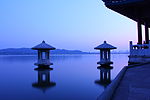
|
Zhejiang | 2011 | 1334; ii, iii, vi (cultural) | The cultural landscape around the lake in Hangzhou has influenced artists, poets, and philosophers since the Tang dynasty. There are numerous temples, pagodas, pavilions, causeways, and gardens, which were designed in line with the Buddhist ideals of peacefulness. The designs were influential in Japan and Korea as well.[46] |
| Chengjiang Fossil Site | 
|
Yunnan | 2012 | 1388; viii (natural) | The fossil site preserves the remains of organisms dating to the early Cambrian, 530 million years ago. This was the period of the rapid diversification of lifeforms. Almost all major groups of animals can trace their origins to this short geological interval. At least 16 phyla have been identified, including the oldest known fossil chordates. The Chengjiang biota illustrates complex food webs in a marine community, with sophisticated predators on top. A fossil of Maotianshania is pictured.[47] |
| Site of Xanadu | 
|
Inner Mongolia | 2012 | 1389; ii, iii, iv, vi (cultural) | Xanadu was the first capital of Kublai Khan and then the summer capital of the Yuan dynasty in the 13th and 14th centuries. Abandoned in 1430 and today preserved as an archaeological site, it demonstrates the integration of Mongol and Han Chinese cultures, combining a Han city plan following the feng shui principles with gardens and landscapes that were essential to the nomadic Mongolian lifestyle. Xanadu was important in the spread of Tibetan Buddhism in north-east Asia.[48] |
| Xinjiang Tianshan | 
|
Xinjiang | 2013 | 1414; vii, ix (natural) | The Tian Shan mountain range is located between two desert regions, Dzungaria in the north and the Tarim Basin in the south. Contrasting the arid surroundings, the mountains have glaciers, forests, meadows, lakes, and rivers. The ecosystems have been preserved since the Pliocene epoch and demonstrate the ongoing biological and ecological evolutionary processes in the temperate zone. The mountains reach above 7,000 m (23,000 ft) (Jengish Chokusu, the highest mountain of the range, pictured) and exhibit a succession of vegetation zones. The area is home to several relict and endangered species.[49] |
| Cultural Landscape of Honghe Hani Rice Terraces | 
|
Yunnan | 2013 | 1111; iii, v (cultural) | On the mountain slopes along the Hong River, over the course of 1300 years, the Hani people have created a cultural landscape with terraces used to grow red rice, their main staple crop. They use a complex integrated system of farming and water management that uses ducks, buffaloes, cattle, and fish to provide fertilizers to the plants. The Hani worship the nature and their land management system is a manifestation of their "Man-God Unity social system".[50] |
| Silk Roads: the Routes Network of Chang'an-Tianshan Corridor* | 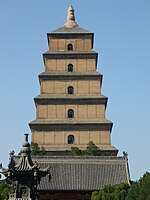
|
Henan, Shaanxi, Gansu, Xinjiang | 2014 | 1442; ii, iii, v, vi (cultural) | The Silk Road is an ancient network of trade routes that started forming in the 2nd century BCE and remained active until the 16th century. The roads connected societies of China, India, Central Asia, Western Asia, and the Near East. In addition to exchange of goods, they also contributed to the spread of technologies, ideologies, and religions, including Buddhism, Nestorian Christianity, Manichaeism, Zoroastrianism, and early Islam. Several towns and supporting infrastructure have been constructed along the routes. This World Heritage site covers the corridors from Chang'an/Luoyang, the Han and Tang capitals of China, to the Zhetysu region of Central Asia, and is shared with Kazakhstan and Kyrgyzstan. 33 sites on the roads are listed, 19 of which are in China. The Giant Wild Goose Pagoda in Xi'an is pictured.[51] |
| The Grand Canal | 
|
Beijing, Tianjin, Hebei, Shandong, Jiangsu, Zhejiang, Anhui, Henan | 2014 | 1443; i, iii, iv, vi (cultural) | The Grand Canal is a vast network of artificial canals running from Beijing to Zhejiang and connecting China's five major river basins. The canal was constructed in stages, with the first ones dating to the 5th century BCE and it got fully connected in the 7th century under the Sui dynasty. It formed the backbone of the imperial monopoly for the transport of grain and strategic raw materials, allowed distribution of food across the country, as well as taxation and movement of the troops. Being the oldest and longest canal in the world, it demonstrates techological innovations with dams, dykes, and weirs, combined with the original use of natural materials. 31 sites along the canal are listed, the Gongchen Bridge in Hangzhou is pictured.[52] |
| Tusi Sites | 
|
Hunan, Hubei, Guizhou | 2015 | 1474; ii, iii (cultural) | The tusi were hereditary rulers of the tribal areas in southwestern China, appointed by the central government between the 13th and 20th centuries. This way of ruling helped unifying the administration on the national level, while nevertheless allowing ethnic minorities to retain their customs and way of life. Three representative sites are listed: Laosicheng, Tangya Tusi Fortress, and Hailongtun (pictured).[53] |
| Zuojiang Huashan Rock Art Cultural Landscape | 
|
Guangxi | 2016 | 1508; iii, vi (cultural) | This site comprises three clusters of rock art dating from 5th to 2nd century BCE. They were interpreted to be created by the Luoyue people of the bronze drum culture, a culture once wide-spread in the region. Rock paintings depict different aspects of ritual and social life.[54] |
| Hubei Shennongjia | 
|
Hubei | 2016 | 1509bis; ix, x (natural) | The area protects the largest primary forests remaining in central China and is exceptionally rich in biodiversity. Different types of forest, including evergreen broad-leaved forest, mixed evergreen, and deciduous broad-leaved forest, are home to several threatened animal species, including the Chinese giant salamander, clouded leopard, and golden snub-nosed monkey. A minor boundary modification of the site took place in 2021.[55] |
| Qinghai Hoh Xil | 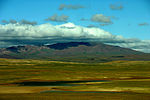
|
Qinghai | 2017 | 1540; vii, x (natural) | Hoh Xil is a part of the Tibetan Plateau, the largest and highest plateau in the world. At an elevation of 4,500 m (14,800 ft), the area experiences year-round low temperatures. Mountain and steppe ecosystems are home to several endemic animal and plant species. There are also hot springs, lakes, and glaciers. The plateau is an important migratory and calving area for the Tibetan antelope. Other large animals include the wild yak, kiang, and goa.[56] |
| Kulangsu: a Historic International Settlement | 
|
Fujian | 2017 | 1541; ii, vi (cultural) | Kulangsu, an island off the commercial port of Xiamen, became the site of an international settlement, established in 1903. It played an important role in the cultural exchange between China and the West. This is reflected in the fusion traditional Fujian architecture with the styles brought by the westerners and the returning overseas Chinese. A particular style, called Amoy Deco, developed as a fusion of Art Deco and Modern architecture.[57] |
| Fanjingshan | 
|
Guizhou | 2018 | 1559; x (natural) | Fanjingshan, part of the Wuling Mountains, is a metamorphic rock formation in an otherwise karst area. There are four vegetation zones on the mountain slopes, from evergreen broadleaf forest at lower elevations to mixed deciduous broadleaf and conifer and scrub forest above 2,200 m (7,200 ft). Located in the monsoon zone, the mountains are a source of water for the surroundings. The area is rich in plant species, especially in bryophytes and gymnosperms. Fanjingshan is the only habitat of the Fanjingshan fir and the gray snub-nosed monkey.[58] |
| Archaeological ruins of Liangzhu City | 
|
Zhejiang | 2019 | 1592; iii, iv (cultural) | The archaeological site, located in the Yangtze Delta, comprises four areas with the remains of the Liangzhu culture, a late Neolithic culture based on rice agriculture dating to c. 3300-2300 BCE. It demonstrates the transition of small-scale societies to larger political entities with social stratification and complex rituals and crafts.[59] |
| Migratory Bird Sanctuaries along the Coast of Yellow Sea-Bohai Gulf of China | 
|
Hebei, Jiangsu, Liaoning, Shandong, Shanghai | 2019 | 1606bis; x (natural) | The wetlands along the Yellow Sea and Bohai Sea serve as crucial stopover, wintering, or breeding sites for birds migrating from the Arctic to South-East Asia and Australasia. Millions of birds migrate along this route annually, with more than 400 species recorded, including the endangered spoon-billed sandpiper (a specimen pictured) and Nordmann's greenshank. The serial site comprises 12 components with wetlands, mudflats, beaches, and marshes, that were inscribed in two phases, in 2019 and 2024.[60] |
| Quanzhou: Emporium of the World in Song-Yuan China | 
|
Fujian | 2021 | 1561rev; iv (cultural) | Quanzhou was China's major port for foreign traders, who knew it as Zaiton, during the 11th through 14th centuries, under the Song and Yuan dynasties. The site comprises religious and administrative buildings, workshops for ceramics and iron objects, transport infrastructure such as bridges and docks, and pagodas that directed the voyagers. The 11th century Qingjing Mosque is one of the oldest Islamic buildings in China.[61] |
| Cultural Landscape of Old Tea Forests of the Jingmai Mountain in Pu’er | 
|
Yunnan | 2023 | 1665; iii, v (cultural) | The cultural landscape, developed since the 10th century by the Bulang and Dai people, is the primary production area of the Pu'er tea (pictured). Located in a favourable monsoon and mountain microclimate, there are old tea grows and plantations, together with traditional villages. Traditions and ceremonies of the villagers originate from the Tea Ancestor belief.[62] |
| Badain Jaran Desert - Towers of Sand and Lakes | 
|
Inner Mongolia | 2024 | 1638; vii, viii (natural) | China's third largest desert features different types of dunes, including stable linear mega-dunes reaching up to 460 m (1,510 ft). There are numerous inter-dunal lakes, mostly saline and home to worms, molluscs, crustaceans, and fish. The desert is also the world's largest expanse of singing sands, referring to the sound produced by the sand moved by the wind.[63] |
| Beijing Central Axis: A Building Ensemble Exhibiting the Ideal Order of the Chinese Capital | 
|
Beijing | 2024 | 1714, iii, vi (cultural) | The Central Axis is an ensemble of palaces, gardens, religious sites, and public buildigns, running in the north-south direction in central Beijing. It was established under the Yuan dynasty in the 13th century, with further buildings added under the Ming and Qing dynasties. The layout follows the Confucian ideas as expressed in the ancient text Kaogongji (Book of Diverse Crafts), depicting an ideal capital.[64] |
Tentative list
[edit]In addition to sites inscribed on the World Heritage List, member states can maintain a list of tentative sites that they may consider for nomination. Nominations for the World Heritage List are only accepted if the site was previously listed on the tentative list.[65] China has 59 sites on its tentative list.[3]
| Site | Image | Location (province) | Year listed | UNESCO criteria | Description |
|---|---|---|---|---|---|
| Dongzhai Port Nature Reserve | 
|
Hainan | 1996 | Natural | 105 |
| The Alligator Sinensis Nature Reserve | 
|
Anhui | 1996 | Natural | 106 |
| Poyang Nature Reserve | 
|
Jiangxi | 1996 | Natural | 107 |
| The Lijiang River Scenic Zone at Guilin | 
|
Guilin | 1996 | Natural | 108 |
| Yalong, Tibet (Yarlung Valley, "cradle of Tibetan culture") | 
|
Tibet | 2001 | Mixed | 1622 |
| Yangtze Gorges Scenic Spot | 
|
Hubei, Chongqing | 2001 | Mixed | 1623 |
| Jinfushan Scenic Spot | 
|
Chongqing | 2001 | Natural: vii, viii, ix | 1624 |
| Heaven Pit and Ground Seam Scenic Spot | 
|
Sichuan, Hubei, Hunan and Guizhou | 2001 | Natural: vii, viii, ix | 1625 |
| Hua Shan Scenic Area | 
|
Shaanxi | 2001 | Mixed | 1626 |
| Yandang Mountain | 
|
Zhejiang | 2001 | Mixed | 1627 |
| Nanxi River | 
|
Zhejiang | 2001 | Mixed | 1629 |
| Maijishan Scenic Spots | 
|
Gansu | 2001 | Mixed | 1631 |
| Wudalianchi Scenic Spots | 
|
Heilongjiang | 2001 | Natural: viii, ix | 1632 |
| Haitan Scenic Spots | 
|
Fujian | 2001 | Natural | 1633 |
| Dali Cangshan Mountain and Erhai Lake Scenic Spot | 
|
Yunnan | 2001 | Mixed | 1634 |
| Sites for Liquor Making in China | 
|
Hebei, Jiangxi, Sichuan | 2008 | Cultural: iii, iv, vi | 5320 |
| Ancient Residences in Shanxi and Shaanxi Provinces (Dingcun and Dangjiacun villages) | 
|
Shanxi, Shaanxi | 2008 | Cultural: ii, iii, iv | 5322 |
| City Walls of the Ming and Qing Dynasties | 
|
Xi'an, Jingzhou, Nanjing, Xingcheng | 2008 | Cultural, iii, iv | 5324 |
| Slender West Lake and Historic Urban Area in Yangzhou | 
|
Jiangsu | 2008 | Cultural: iii, iv, v | 5327 |
| Ancient Water Towns South of the Yangtze River (Zhouzhuang, Luzhi, Wuzhen, and Xitang) | 
|
Zhejiang, Jiangsu | 2008 | Cultural: ii, iv, v | 5328 |
| Chinese Section of the Silk Road: Land routes in Henan, Shaanxi, Gansu, Qinghai, Ningxia, and Xinjiang; Sea Routes in Ningbo, and Quanzhou City, - from Western-Han Dynasty to Qing Dynasty | 
|
Shaanxi, Gansu, Xinjiang, Zhejiang, Fujian | 2008 | Cultural: i, ii, iii, iv, v, vi | 5335 |
| Fenghuang Ancient City | 
|
Hunan | 2008 | Cultural: i, ii, iii, iv | 5337 |
| Sites of the Southern Yue State | 
|
Guangdong | 2008 | Cultural: ii, iii | 5338 |
| Baiheliang Ancient Hydrological Inscription | 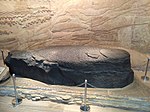
|
Chongqing | 2008 | Cultural: iii, iv | 5341 |
| Miao Nationality Villages in Southeast Guizhou Province: The villages of Miao Nationality at the Foot of Leigong Mountain in Miao Ling Mountains | 
|
Guizhou | 2008 | Cultural: i, iv, v, vi | 5344 |
| Karez Wells | 
|
Xinjiang | 2008 | Cultural: i, iv, v | 5347 |
| Expansion Project of Imperial Tombs of the Ming and Qing Dynasties: King Lujian’s Tombs (Mausoleum of the Prince Jian of Lu in Xinxiang) | 
|
Henan | 2008 | Cultural: ii, iii, iv, vi | 5351 |
| The Four Sacred Mountains as an extension of Mt. Taishan | 
|
Shanxi, Shaanxi | 2008 | Mixed: i, ii, iii, iv, vi, vii, viii | 5353 |
| Taklimakan Desert–Populus euphratica Forests | 
|
Xinjiang | 2010 | Natural: viii, ix, x | 5532 |
| China Altay | 
|
Xinjiang | 2010 | Natural: vii, viii, ix | 5533 |
| Karakorum–Pamir | 
|
Xinjiang | 2010 | Natural: viii, x | 5535 |
| Wooden Structures of Liao Dynasty – Wooden Pagoda of Yingxian County, Main Hall of Fengguo Monastery of Yixian County | 
|
Shanxi, Liaoning | 2013 | Cultural: i, iii, iv | 5803 |
| Sites of the Hongshan Culture: Niuheliang, Hongshanhou, and Weijiawopu | 
|
Liaoning, Inner Mongolia | 2013 | Cultural: i, iii, iv | 5804 |
| Ancient Porcelain Kiln Site in China (Shanglin Lake Yue Kilns and Longquan Kiln Sites at Dayao) | 
|
Zhejiang | 2013 | Cultural: ii, iii, iv | 5806 |
| Sanfang Qixiang | 
|
Fujian | 2013 | Cultural: iii, iv | 5808 |
| Western Xia Imperial Tombs | 
|
Ningxia | 2013 | Cultural: iii | 5811 |
| Dong Villages | 
|
Hunan, Guangxi | 2013 | Cultural: iii, iv, v | 5813 |
| Lingqu Canal | 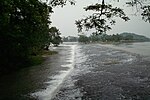
|
Guangxi | 2013 | Cultural: i, iv, vi | 5814 |
| Diaolou Buildings and Villages for Tibetan and Qiang Ethnic Groups | 
|
Suchuan | 2013 | Cultural: i, ii, iii, iv, v | 5815 |
| Archaeological Sites of the Ancient Shu State: Jinsha site and Joint Tombs of Boat-shaped Coffins in Chengdu, Sichuan; Sanxingdui site in Guanghan, 29th – 5th century BC | 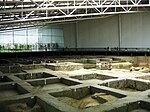
|
Sichuan | 2013 | Cultural: i, ii, iii, v | 5816 |
| Xinjiang Yardang | 
|
Xinjiang | 2015 | Natural: vii, viii | 5989 |
| Dunhuang Yardangs | 
|
Gansu | 2015 | Natural: vii, viii | 5990 |
| Tianzhushan | 
|
Anhui | 2015 | Mixed: ii, iii, v, vi, vii, viii | 5992 |
| Jinggangshan–North Wuyishan | 
|
Jiangxi, Hunan | 2015 | Mixed: iii, vi, vii, x | 5993 |
| Shudao | 
|
Sichuan | 2015 | Mixed: ii, iii, iv, vi, vii, x | 5994 |
| Tulin–Guge Scenic and Historic Interest Areas | 
|
Tibet | 2015 | Mixed: ii, iii, v, vi, vii, viii | 5995 |
| Guancen Mountain – Luya Mountain (part of the Lüliang Mountains) | 
|
Shanxi | 2017 | Natural: vii, ix | 6184 |
| Hulun Buir Landscape and Birthplace of Ancient Minority | 
|
Inner Mongolia | 2017 | Natural: iii, vii, ix, x | 6185 |
| Qinghai Lake | 
|
Qinghai | 2017 | Natural: vii, ix, x | 6186 |
| Scenic and historic area of Sacred Mountains and Lakes (Gang Rinpoche, Naimona'nyi, Lake Manasarovar and Lhanag-tso) | 
|
Tibet | 2017 | Mixed: iii, v, vi, vii, viii, x | 6187 |
| Taihang Mountain | 
|
Hebei, Shanxi, Henan | 2017 | Mixed: iii, vii, viii, x | 6188 |
| Vertical Vegetation Landscape and Volcanic Landscape in Changbai Mountain | 
|
Jillin | 2017 | Natural: vii, viii, ix, x | 6190 |
| Guizhou Triassic Fossil Sites | 
|
Guizhou | 2019 | Natural: viii | 6381 |
| Huangguoshu Scenic Area | 
|
Guizhou | 2019 | Mixed: v, vii, viii | 6380 |
| Hainan Tropical Rainforest and the Traditional Settlement of Li Ethnic Group | 
|
Hainan | 2022 | Mixed: iii, v, x | 6582 |
| Fujian Minjiang River Estuary: The ecotone between marine and terrestrial biogeographical regions | 
|
Fujian | 2022 | Natural: x | 6619 |
| Hezheng Mammalian Fossil Sites of Gansu | 
|
Gansu | 2024 | Natural: viii | 6768 |
See also
[edit]- List of UNESCO Biosphere Reserves in China
- Major Historical and Cultural Sites Protected at the National Level
- Principles for the Conservation of Heritage Sites in China
References
[edit]- ^ "The World Heritage Convention". UNESCO World Heritage Centre. Archived from the original on 27 August 2016. Retrieved 21 September 2010.
- ^ "Convention Concerning the Protection of the World Cultural and Natural Heritage". UNESCO World Heritage Centre. Archived from the original on 1 February 2021. Retrieved 3 February 2021.
- ^ a b c d "China". UNESCO World Heritage Centre. Retrieved 19 January 2025.
- ^ "World Heritage List". UNESCO World Heritage Centre. Archived from the original on 2 November 2020. Retrieved 20 December 2024.
- ^ "The Criteria for Selection". UNESCO World Heritage Centre. Archived from the original on 12 June 2016. Retrieved 17 August 2018.
- ^ "Mount Taishan". UNESCO World Heritage Centre. Retrieved 19 January 2025.
- ^ "The Great Wall". UNESCO World Heritage Centre. Retrieved 19 January 2025.
- ^ "Imperial Palaces of the Ming and Qing Dynasties in Beijing and Shenyang". UNESCO World Heritage Centre. Retrieved 19 January 2025.
- ^ "Mausoleum of the First Qin Emperor". UNESCO World Heritage Centre. Retrieved 19 January 2025.
- ^ "Mausoleum of the First Qin Emperor". UNESCO World Heritage Centre. Retrieved 19 January 2025.
- ^ "Peking Man Site at Zhoukoudian". UNESCO World Heritage Centre. Retrieved 19 January 2025.
- ^ "Mount Huangshan". UNESCO World Heritage Centre. Retrieved 19 January 2025.
- ^ "Jiuzhaigou Valley Scenic and Historic Interest Area". UNESCO World Heritage Centre. Retrieved 19 January 2025.
- ^ "Huanglong Scenic and Historic Interest Area". UNESCO World Heritage Centre. Retrieved 19 January 2025.
- ^ "Wulingyuan Scenic and Historic Interest Area". UNESCO World Heritage Centre. Retrieved 19 January 2025.
- ^ "Mountain Resort and its Outlying Temples, Chengde". UNESCO World Heritage Centre. Retrieved 19 January 2025.
- ^ "Temple and Cemetery of Confucius and the Kong Family Mansion in Qufu". UNESCO World Heritage Centre. Retrieved 19 January 2025.
- ^ "Ancient Building Complex in the Wudang Mountains". UNESCO World Heritage Centre. Retrieved 19 January 2025.
- ^ "Historic Ensemble of the Potala Palace, Lhasa". UNESCO World Heritage Centre. Retrieved 19 January 2025.
- ^ "Lushan National Park". UNESCO World Heritage Centre. Retrieved 19 January 2025.
- ^ "Mount Emei Scenic Area, including Leshan Giant Buddha Scenic Area". UNESCO World Heritage Centre. Retrieved 19 January 2025.
- ^ "Old Town of Lijiang". UNESCO World Heritage Centre. Retrieved 19 January 2025.
- ^ "Ancient City of Ping Yao". UNESCO World Heritage Centre. Retrieved 19 January 2025.
- ^ "Classical Gardens of Suzhou". UNESCO World Heritage Centre. Retrieved 19 January 2025.
- ^ "Summer Palace, an Imperial Garden in Beijing". UNESCO World Heritage Centre. Retrieved 19 January 2025.
- ^ "Temple of Heaven: an Imperial Sacrificial Altar in Beijing". UNESCO World Heritage Centre. Retrieved 19 January 2025.
- ^ "Mount Wuyi". UNESCO World Heritage Centre. Retrieved 19 January 2025.
- ^ "Dazu Rock Carvings". UNESCO World Heritage Centre. Retrieved 19 January 2025.
- ^ "Mount Qingcheng and the Dujiangyan Irrigation System". UNESCO World Heritage Centre. Retrieved 19 January 2025.
- ^ "Ancient Villages in Southern Anhui – Xidi and Hongcun". UNESCO World Heritage Centre. Retrieved 19 January 2025.
- ^ "Longmen Grottoes". UNESCO World Heritage Centre. Retrieved 19 January 2025.
- ^ "Imperial Tombs of the Ming and Qing Dynasties". UNESCO World Heritage Centre. Retrieved 19 January 2025.
- ^ "Yungang Grottoes". UNESCO World Heritage Centre. Retrieved 19 January 2025.
- ^ "Three Parallel Rivers of Yunnan Protected Areas". UNESCO World Heritage Centre. Retrieved 19 January 2025.
- ^ "Capital Cities and Tombs of the Ancient Koguryo Kingdom". UNESCO World Heritage Centre. Retrieved 19 January 2025.
- ^ "Historic Centre of Macao". UNESCO World Heritage Centre. Retrieved 19 January 2025.
- ^ "Yin Xu". UNESCO World Heritage Centre. Retrieved 19 January 2025.
- ^ "Sichuan Giant Panda Sanctuaries - Wolong, Mt Siguniang and Jiajin Mountains". UNESCO World Heritage Centre. Retrieved 19 January 2025.
- ^ "Kaiping Diaolou and Villages". UNESCO World Heritage Centre. Retrieved 19 January 2025.
- ^ "South China Karst". UNESCO World Heritage Centre. Retrieved 19 January 2025.
- ^ "Fujian Tulou". UNESCO World Heritage Centre. Retrieved 19 January 2025.
- ^ "Mount Sanqingshan National Park". UNESCO World Heritage Centre. Retrieved 19 January 2025.
- ^ "Mount Wutai". UNESCO World Heritage Centre. Retrieved 19 January 2025.
- ^ "Historic Monuments of Dengfeng in "The Centre of Heaven and Earth"". UNESCO World Heritage Centre. Retrieved 19 January 2025.
- ^ "China Danxia". UNESCO World Heritage Centre. Retrieved 19 January 2025.
- ^ "West Lake Cultural Landscape of Hangzhou". UNESCO World Heritage Centre. Retrieved 19 January 2025.
- ^ "Chengjiang Fossil Site". UNESCO World Heritage Centre. Retrieved 19 January 2025.
- ^ "Site of Xanadu". UNESCO World Heritage Centre. Retrieved 19 January 2025.
- ^ "Xinjiang Tianshan". UNESCO World Heritage Centre. Retrieved 19 January 2025.
- ^ "Cultural Landscape of Honghe Hani Rice Terraces". UNESCO World Heritage Centre. Retrieved 19 January 2025.
- ^ "Silk Roads: the Routes Network of Chang'an-Tianshan Corridor". UNESCO World Heritage Centre. Archived from the original on 13 February 2021. Retrieved 16 October 2021.
- ^ "The Grand Canal". UNESCO World Heritage Centre. Retrieved 19 January 2025.
- ^ "Tusi Sites". UNESCO World Heritage Centre. Retrieved 19 January 2025.
- ^ "Zuojiang Huashan Rock Art Cultural Landscape". UNESCO World Heritage Centre. Retrieved 19 January 2025.
- ^ "Hubei Shennongjia". UNESCO World Heritage Centre. Retrieved 19 January 2025.
- ^ "Qinghai Hoh Xil". UNESCO World Heritage Centre. Retrieved 19 January 2025.
- ^ "Kulangsu, a Historic International Settlement". UNESCO World Heritage Centre. Retrieved 19 January 2025.
- ^ "Fanjingshan". UNESCO World Heritage Centre. Retrieved 19 January 2025.
- ^ "Archaeological ruins of Liangzhu City". UNESCO World Heritage Centre. Retrieved 19 January 2025.
- ^ "Migratory Bird Sanctuaries along the Coast of Yellow Sea-Bohai Gulf of China". UNESCO World Heritage Centre. Retrieved 19 January 2025.
- ^ "Quanzhou: Emporium of the World in Song-Yuan China". UNESCO World Heritage Centre. Retrieved 19 January 2025.
- ^ "Cultural Landscape of Old Tea Forests of the Jingmai Mountain in Pu'er". UNESCO World Heritage Centre. Retrieved 19 January 2025.
- ^ "Badain Jaran Desert - Towers of Sand and Lakes". UNESCO World Heritage Centre. Retrieved 19 January 2025.
- ^ "Beijing Central Axis: A Building Ensemble Exhibiting the Ideal Order of the Chinese Capital". UNESCO World Heritage Centre. Retrieved 19 January 2025.
- ^ "Tentative Lists". UNESCO World Heritage Centre. Archived from the original on 1 April 2016. Retrieved 7 October 2010.
World Heritage Sites in China.



